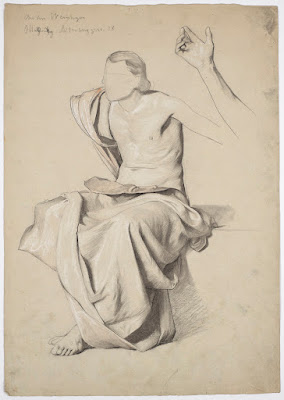 |
| Giacomo Cavedone Mourning Virgin ca. 1640 drawing Morgan Library, New York |
 |
| Anonymous Venetian Artist God the Father ca. 1480 marble relief Bode Museum, Berlin |
 |
| Jules Cayron Isabelle d'Orléans, duchesse de Guise ca. 1932 oil on canvas Musée Carnavalet, Paris |
 |
| Edward Burne-Jones Study of Seated Woman ca. 1870 drawing Art Gallery of South Australia, Adelaide |
-Antikensammlung-Staatliche-Museen-zu-Berlin.jpg) |
| Hellenistic Greek Culture Aphrodite 1st century BC-2nd century AD marble (excavated on Corfu) Antikensammlung, Staatliche Museen zu Berlin |
 |
| Jean Heiberg Orchids 1917 oil on canvas Göteborgs Konstmuseum, Sweden |
 |
| Anonymous Roman Artist St Bruno in Prayer ca. 1650-1700 oil on canvas Christ Church Picture Gallery, Oxford |
 |
| Franz von Matsch Study of Draped Figure 1883 drawing Belvedere Museum, Vienna |
 |
| Jürgen Ovens Christian Albrecht, Duke of Schleswig-Holstein-Gottorp with consort Frederikke Amalie, as Shepherd and Shepherdess ca. 1670-80 oil on canvas Nasjonalmuseet, Oslo |
-National-Museum-Warsaw.jpg) |
| Angelica Kauffmann Domenica Morghen as the Muse of Tragedy and Maddalena Volpato as the Muse of Comedy 1791 oil on canvas (painted in Rome) National Museum, Warsaw |
 |
| Lorenzo Lippi Archduchess Isabella Klara of Austria 1652 oil on canvas Kunsthistorisches Museum, Vienna |
-c1455-60-tempera-and-oil-on-panel-Gem%C3%A4ldegalerie-Staatliche-Museen-zu-Berlin.jpg) |
| Anonymous Ferrarese Artist The Muse Polyhymnia (as inventor of Agriculture) ca. 1455-60 tempera and oil on panel Gemäldegalerie, Staatliche Museen zu Berlin |
-Museumslandschaft-Hessen-Kassel.jpg) |
| Roman Empire Athena AD 160-170 marble (formerly in Palazzo Verospi, Rome) Museumslandschaft Hessen Kassel |
 |
| attributed to Matteo Rosselli Standing Figure before 1650 drawing Hamburger Kunsthalle |
 |
| Émile Signol Christ and the Woman taken in Adultery 1842 oil on canvas Detroit Institute of Arts |
 |
| Carl Bloch A Roman Osteria 1866 oil on canvas Statens Museum for Kunst, Copenhagen |
"These arguments continued on both sides until the time of day when the yeoman looses his ox from the plough, when the blustery wind began to ease, slackening little by little until it was blowing in our sails with ineffectual weakness, merely rippling the canvas with no forward thrust. Eventually it subsided into complete calm, as if it were departing with the setting sun, or, more truthfully, as if it were collaborating with our pursuers. For as long as we were running before the wind, the cutter and her crew lagged far astern of our merchantman, as one might have expected with our larger sails catching more of the wind; but when we were becalmed upon a smooth sea and forced to take to our oars, they were upon us quicker than it takes to tell, for the whole crew was rowing hard, I imagine, to propel their cutter, which was a nimble craft and more responsive to the oar than our vessel."
– Heliodorus, from The Aethiopica, or, Theagenes and Charikleia (3rd or 4th century AD), translated from Greek by J.R. Morgan (1989)